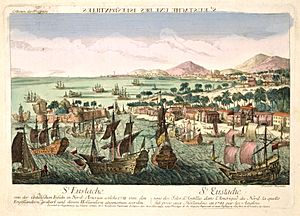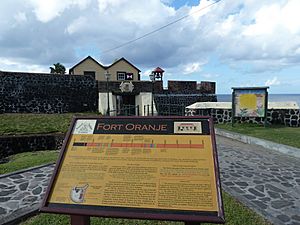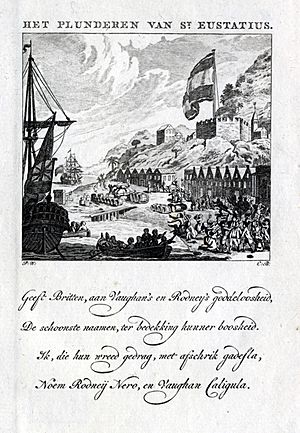Capture of Sint Eustatius facts for kids
The Capture of Sint Eustatius happened in February 1781 during the Fourth Anglo-Dutch War. British soldiers and sailors, led by Lieutenant-General Sir John Vaughan and Admiral George Rodney, took control of the Dutch island of Sint Eustatius in the Caribbean. This event caused some debate in Britain. People said that Vaughan and Rodney had focused too much on getting rich instead of their military duties. Later in 1781, French forces, who were allies of the Dutch, recaptured the island. This ended the British control.
Why Sint Eustatius Was Important
Sint Eustatius, a small island controlled by the Dutch in the West Indies, was a very busy trading hub. It became even more important during the American War of Independence. Britain had blocked many shipping routes, making it hard to send supplies directly to American ports.
- Sint Eustatius became a key place for supplies. Its harbor was full of American trading ships.
- After France joined the war in 1778, the island also helped supply the French islands.
- It's thought that about half of all military supplies for the American Revolution passed through Sint Eustatius.
- Dutch and Jewish merchants on the island were vital for shipping goods to the American forces.
- Communications between the US and Europe often went through Sint Eustatius.
In 1776, Sint Eustatius (and the Dutch) were the first to officially recognize the American Revolutionary government. This happened when the American ship, the Andrew Doria, fired a 13-gun salute upon its arrival. Fort Orange on Sint Eustatius returned an 11-gun salute. The Andrew Doria came to buy military supplies and give the Dutch governor a copy of the US Declaration of Independence.
Britain's leaders were angry that Sint Eustatius was helping their enemies. Admiral Rodney believed that goods from British convoys were being sold to the American rebels through the island. He even said he wanted to "scourge" the island. He had identified people on Sint Eustatius who were helping the enemy. When war broke out between the Dutch Republic and Britain in December 1780, orders were sent from London to seize the island. The British had an advantage because the news of the war hadn't reached Sint Eustatius yet.
How the Island Was Captured
A British force of 3,000 soldiers sailed from Saint Lucia on January 30, 1781. Rodney left some ships behind to watch the French on Martinique. He also sent Samuel Hood ahead to stop any merchant ships from leaving the harbor. The main British force arrived off Sint Eustatius on February 3.
- Rodney's ships took positions to stop any attacks from shore cannons.
- Only one Dutch warship, the frigate Mars, fired a few shots.
- Instead of attacking right away, Rodney sent a message to Governor Johannes de Graaff. He suggested surrendering to avoid fighting.
- De Graaff agreed and surrendered. He had only ten cannons at Fort Orange and sixty soldiers. Rodney had over 1,000 cannons on his ships.
- By the next day, the nearby islands of Saint Martin and Saba had also surrendered.
There was a short exchange of fire when two British ships shot at the Mars. Captain Van Bijland of the Mars fired back. Rodney then told his captains off for this lack of discipline.
The only real battle happened near Sombrero. Rodney learned that a convoy of thirty Dutch merchant ships, full of valuable goods, had left for the Netherlands just two days before he arrived. They were protected by only one warship. He sent three British warships after them. They quickly caught up with the convoy. The single Dutch warship was no match for the three British ships. After about 30 minutes of heavy firing, the Dutch commander, Rear-Admiral Willem Krul, was badly wounded. As he was dying, he ordered his captain to lower the flag. Eight Dutch crew members were killed. Krul was brought back to Sint Eustatius and buried with full military honors.
The crews of all Dutch ships taken at Sint Eustatius, and those from Krul's convoy, had their belongings taken. They were then sent to St. Kitts and imprisoned.




